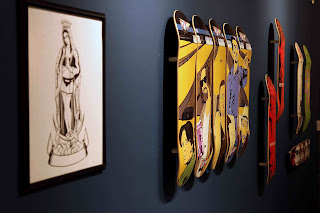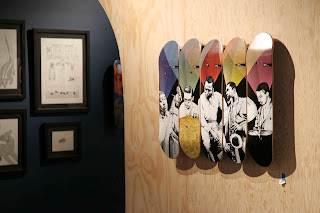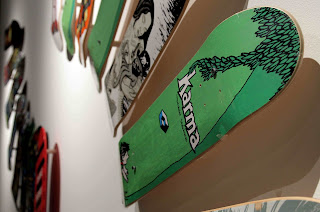Enjoy Every Sandwich
 |
| These guys are soft packin' |
IE Weekly
By Arrissia Owen
The Soft Pack lives by the words of the late Warren Zevon
“This one’s for Warren Zevon,” singer Matt Lamkin shouted to millions of TV viewers just before his band The Soft Pack launched into a rousing rendition of its single “Answer to Yourself.” That was February 2010, and Lamkin and company were in New York promoting the self-titled LP on Late Show with David Letterman.The LA-based band has been on tour ever since, promoting the tracks while writing and recording songs for its upcoming fall release. The unexpected shout out sent a jolt through Letterman’s staff, guitarist Matty McLoughlin fondly recalls.
Zevon was a frequent guest and friend of Letterman who choked up the host on air in 2003 during his last Late Show appearance months before he succumbed to lung cancer. The Matts, who are huge Zevon fans along with drummer Brian Hill and bassist David Lantzman, spent time chatting with staff afterward, getting earfuls of anecdotes about the sardonic songwriter.
That performance was one of many highlights for the band during the last two years. Letterman is up there with 2010 slots at Coachella and South by Southwest, “Answer to Yourself” fueling beer commercial bravado and opening for bands like the Breeders and Franz Ferdinand.
These days The Soft Pack heads through the IE on Wednesday, April 11, opening for Arctic Monkeys at The Glass House in Pomona, followed by the Moon Block Party Thursday, April 12, with Dengue Fever at Dillion’s Roadhouse in Palm Springs.
While the band shared stages with heavy hitters, The Soft Pack boasts its own dedicated followers. Its fans freak for the deadpan deliverance of jangly pop reminiscent of post-punk forefathers the Modern Lovers and Manchester band The Fall.
The Soft Pack formed in San Diego in 2007 after McLoughlin returned from Virginia after college. McLoughlin and Lamkin, who was still in high school, hung out and wrote songs while geeking out over their shared love for the aforementioned bands, as well as Hot Snakes, The Velvet Underground, Iggy Pop, The Kinks, R.E.M. and, for variety, Steely Dan.
“We wanted to do repetition and simplicity,” McLoughlin says, with a nod to Mark E. Smith’s musical philosophy, The Fall’s cultish frontman. “Everything else was just up in the air.” The result is Lamkin’s lyrics that dryly dismiss any sort of hype, adoration or ambition over grinding guitars, a stomping backbeat and funky bass lines that maintain that sought-after straightforwardness.
By 2008, The Soft Pack, then known by its much-maligned name The Muslims, relocated to Los Angeles. The moniker attracted negative press, even some racist rants. The music itself was getting rave reviews though, so the group ditched the diversion.
To give fans and the press something else to talk about, the band members set aside their apathy for ambition and tore through 10 shows in 13 hours throughout the Los Angeles area.
“It was cool, but really exhausting,” McLoughlin says about the marathon musical tour that the L.A. Times hopped on the bus for. “I think we will be doing something less exhausting this time.” The band has spring and summer to figure out its next move.
The upcoming release is more diverse, McLoughlin says, with more instrumentation added. Fans can also anticipate some robust beats thanks to Lamkin’s affinity for Funkadelic, Sun Ra and Sly and the Family Stone. “Sonically, there is more soul. It’s bare bones, but it’s still rock music, pop songs. It sounds bigger.”
The recordings are under wraps, but fans can catch sneak peeks as the band continues to tour, something they’ve taken little time off from. But don’t expect any road warrior ramblings to creep into their repertoire.
“When people start writing about the road, that starts sounding very Bon Jovi, and that’s boring,” McLoughlin says with a laugh, preferring Zevon’s take on the whole Wanted-Dead-or-Alive thing. “That’s dumb. Who wants to write about sitting in a van?” The boys are more excitable than that.
The Soft Pack w/Arctic Monkeys at The Glass House, 200 W. 2nd St., Pomona, (909) 865-3802; www.glasshouse.us. Wed, April 11. 7pm. $35.
For the original post, visit here: http://ieweekly.com/2012/04/music-2/music/enjoy-every-sandwich/




